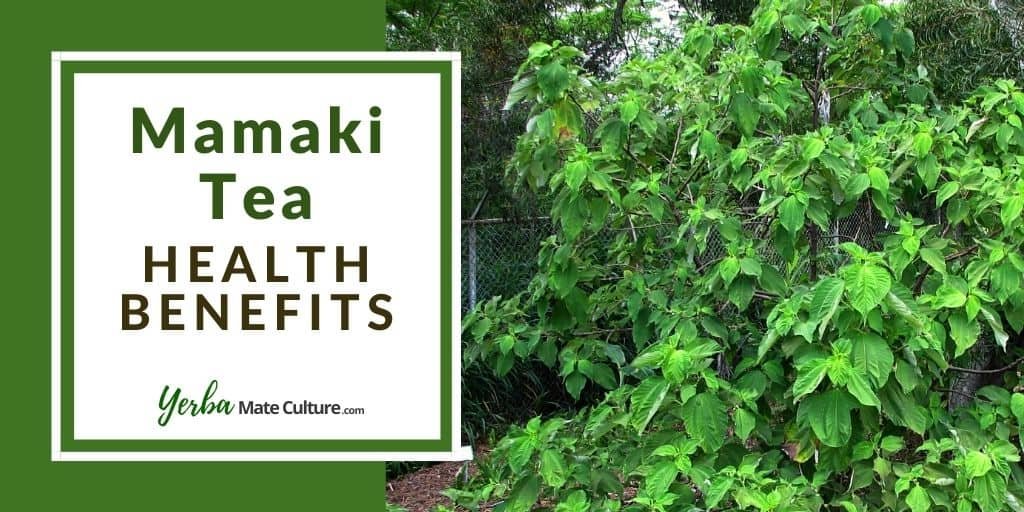Herbal tea drinkers are usually on the hunt for plants that have medicinal benefits and are safe for human consumption. Teas made of herbs such as ginger, chamomile, turmeric, spearmint, peppermint, and echinacea are quite common and widely available.
But have you heard about the endemic mamaki plant and its health benefits?
In this article, I’ll tell you all about mamaki tea’s benefits and possible side effects, the plant’s traditional medicinal use, and how to prepare it at home.
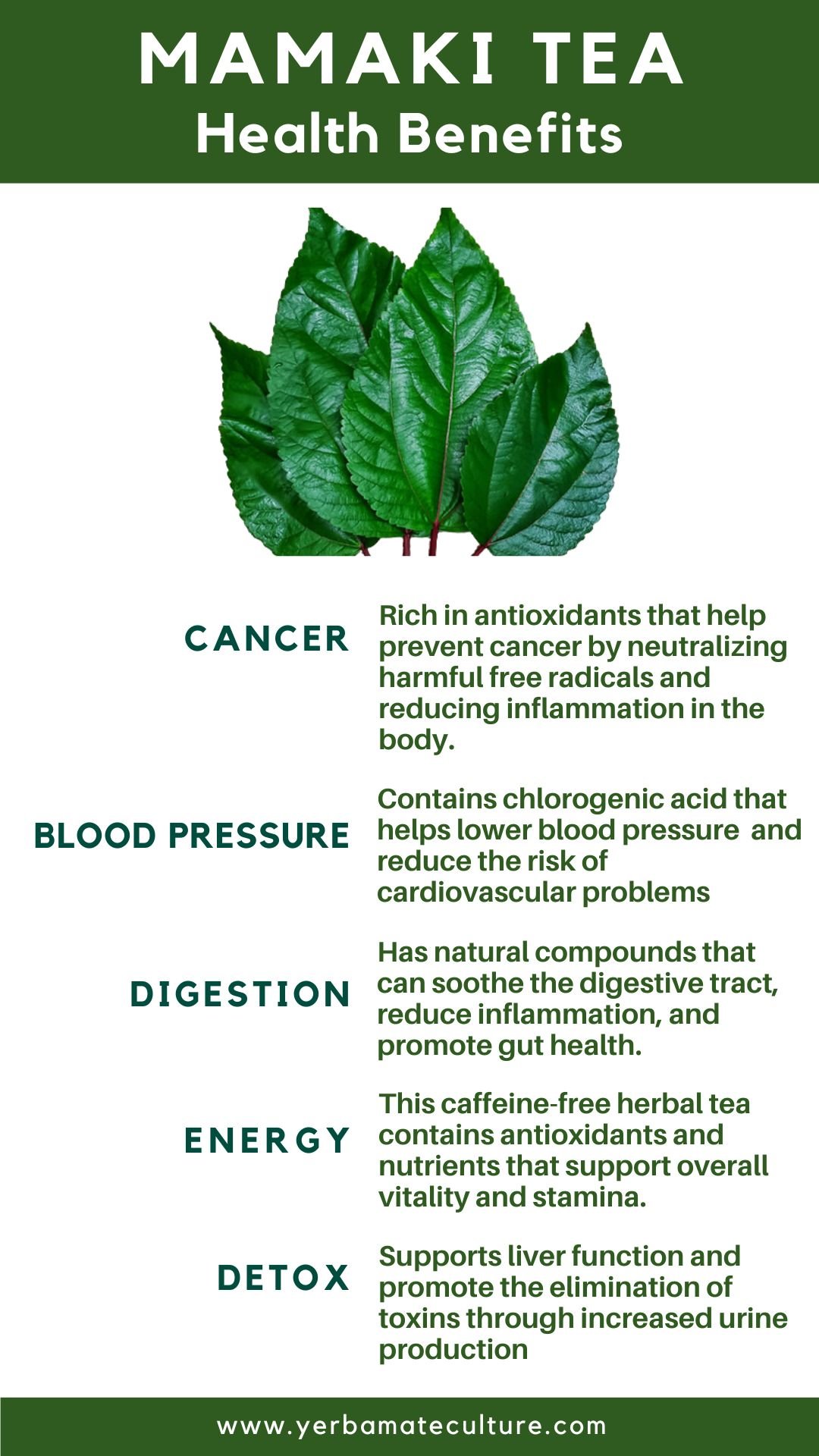
Mamaki Plant
Mamaki (Pipturus albidus), also called Waimea, is a variable flowering plant with as many as up to 10 species. It is native to all the main Hawaiian islands except Ni’ihau and Kaho’olawe.
Pipturus albidus can grow as a shrub or a small tree with a height of between 6 to 20 feet tall. The plant grows all year round and does well in sunshine and moist to wet conditions.
Mamaki has a grayish-brown to reddish-brown bark and large mature leaves that measure between 2 to 12 inches long and 2 to 6 inches wide. The leaves are dark green on the surface and a whitish-gray underneath. The shapes of the leaves are wide-ranging but may be oblong, oval, heart-shaped, or diamond-shaped with serrated edges and veins that vary in color.
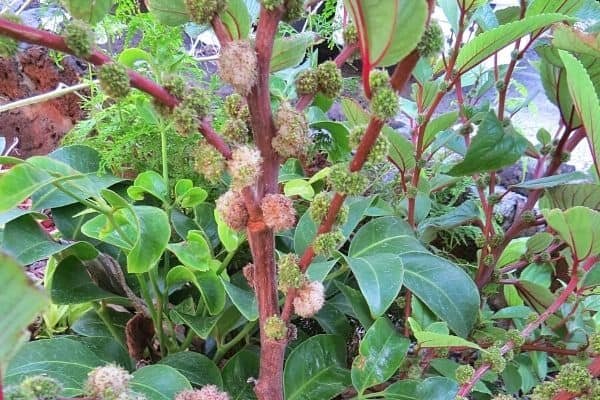
Mamaki produces a white edible fruit that looks like raspberries and has a subtle sweet taste.
Mamaki Species
Mamaki is a relative of the Urticaceae family of plants which include olona and stinging nettles. There are four different species in Hawaii that are quite similar:
- Plants with green leaves and green veins
- Plants with green leaves and red veins
- Plants with green leaves and purple veins
- Plants with green leaves and pink veins
Māmaki keʻokeʻo (green-veined leaves) and māmaki ʻulaʻula (red-veined leaves) species are most commonly used for medicinal purposes.
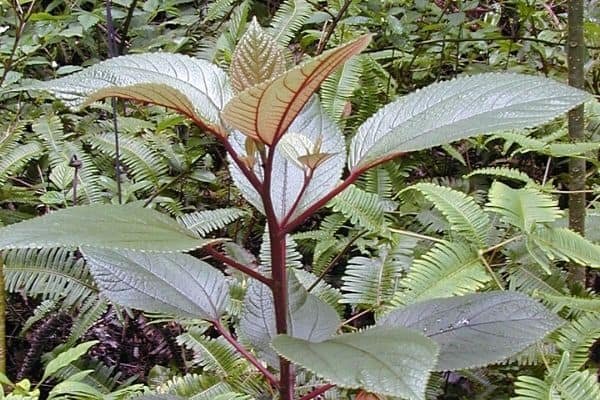
History of Medical Use
Mamaki is embraced as a ancient medicinal plant by the Hawaiians who believe it is a “miracle plant” that can cure many ailments. Although it is also found in countries such as the Philippines, Papua New Guinea, and Micronesia, I will focus on the traditional and modern use of mamaki in Hawaii.
Mamaki is one of the only native Hawaiian plants suitable for herbal tea preparation. The tea is loved for its nutritive value, medicinal benefits, and light uplifting flavor reminiscent of green tea with a hint of lemon.
Traditional Use
Some Hawaiian herbalists prefer the leaves with red veins and others the leaves with green veins. Some have no preference and use any of the plant’s leaves, bark, and berries for medicinal purposes.
Traditionally, mamaki fruit was given to children as a laxative and a treatment for thrush. The berries were also used to treat wounds and sores while the seeds were used as a tonic for infants and adults. Pregnant women ate the fruits and seeds for morning sickness and in the final months of pregnancy to aid in safe childbirth.
A publication by Henny Kartika, from the University of Hawaii, Graduate Division, noted the antioxidant, antibacterial, anti-viral, and anti-fungal properties of mamaki.
The research findings suggest the herb is traditionally used for:
- Increasing energy
- Lowering high blood pressure
- Lowering high cholesterol levels
- Treating diabetes
- Treating the herpes simplex virus (HSV) 1 and 2
Modern Use
Both fresh and dried leaves can be used to make mamaki tea for soothing indigestion and alleviating disorders of the liver, bladder, colon, and bowels. The herbal tea may also have therapeutic benefits for depression.
David Bruce Leonard, the founder of the Earth Medicine Institute and practitioner of traditional Chinese medicine (TCM), refers to mamaki as a “A remarkable friend,….” Leonard continues, “…māmaki has a soothing effect on the nervous system in a similar way to jasmine tea.”
Modern-day drinkers of mamaki tea believe that an herbal infusion of the leaves or bark helps with fatigue, pain, allergies, prostate problems, weight loss, and detoxing the body.
Mamaki Medicinal Compounds
Mamaki is a special plant to the Hawaiians because it contains biochemical compounds that may have wide-ranging therapeutic benefits.
The compounds include the following three major polyphenols (phytochemicals) found in mamaki leaves:
- Catechins: An antioxidant believed to help fight diseases and cell damage.
- Chlorogenic acid: An antioxidant thought to help lower blood pressure.
- Rutin: A flavonoid believed to help with weight loss.
The leaves of Pipturus albidus are said to have a higher concentration of catechins and rutin than Gyokuro green tea leaves, Kenya black tea leaves, and Chinese oolong tea. In terms of nutritive value, mamaki leaves contain the macronutrients carbohydrates, fat, protein, and fibers, and minerals such as calcium, phosphorus, magnesium, iron, boron, and zinc.
Mamaki Tea Benefits
Scientific research done so far suggests that the plant may help prevent diseases such as cancer, lower blood pressure, relieve stress, boost energy, relieve certain digestive disorders, and detoxify the body.
One study even reported that Pipturus albidus (Gray) leaves and bark seems to inhibit replication of the human immunodeficiency virus Type 1 (HIV-1).
1. Prevents Cancer
Healthy antioxidants are available in many plants, including mamaki, and are touted as important for preventing diseases. They play a key role in preventing free radicals chain reactions that lead to toxic build-up and cell damage.
Scientists find that antioxidants can prevent cancer by neutralizing the harmful effects of free radicals that cause cell damage.
Cellular DNA damage is thought to be the underlying cause of cancer. Based on the same mechanism of action, the antioxidants catechins found in mamaki may help prevent cancer by reducing oxidative damage. Mamaki purple-veined leaves are said to have the highest concentrations of the phenolic compound catechins, according to the earlier mentioned study by Henny Kartika.
2. Reduces Blood Pressure
The polyphenol chlorogenic acid (CGA) is found abundantly in foods such as green tea, black tea, green coffee beans, and mamaki leaves. CGA found in mamaki leaves, and mamaki tea, may exert blood pressure lowering effects on the body. Mamaki tea is also cholesterol-free.
A in vitro study on the effects of chlorogenic acid in green coffee beans found that chlorogenic acid effectively reduced blood pressure in the tested subjects. The study concluded that CGA from green coffee bean extract may be safe for patients with mild hypertension.
Another study concluded that the CGA in green tea and black tea not only decreases blood pressure but can play a key role in reducing the risk of cardiovascular problems.
3. Aids Digestion
Catechins found in mamaki leaves and mamaki tea may support digestive health similar to green tea. Hawaiians who practice folk medicine brew tea from the leaves to relieve indigestion, bloating, gas, constipation, and irritable bowel syndrome (IBS).
Catechins pharmacological properties include anti-inflammatory, anti-bacterial, and anti-oxidative effects. The plant’s positive effects on the gastrointestinal tract are linked to the antioxidative abilities of catechins.
While green tea contains more catechins than black tea and oolong tea, mamaki is said to contain more than all three teas.
4. Boosts Energy
In Hawaiian culture, Pipturus albidus is also thought to be a herbal remedy for disabilities such as “run down” (loss of energy), fatigue, and stress. Traditional herbalists attribute it to the catechin content of mamaki.
Many Hawaiians sip on cold mamaki tea on hot days to refresh and rejuvenate. One interesting thing about mamaki tea energy-boosting abilities is there are no caffeine withdrawal symptoms such as lethargy and irritability since it is caffeine-free.
5. Detoxifies the Body
Mamaki is also believed to be a plant that supports liver function through its ability to detox the body. This may be due to the scavenging activities of catechins and chlorogenic acid it contains.
A publication by the University of Hawaii Manoa, College of Tropical Agriculture and Human Resources lists the use of the plant parts. According to the publications, the leaves, bark, and stem of mamaki are consumed as a laxative and for blood purification. Additionally, the fresh and dried leaves are used as a “cleansing agent.”
Mamaki Tea Side Effects
There are no reports of side effects amongst the Hawaiians during centuries of consuming mamaki tea. Furthermore, the studies related to the herb have not indicated any adverse effects.
However, more research is needed to make sure that this herbal tea is safe for everyrone.
How to Make Hawaiian Mamaki Herbal Tea
Refresh and rejuvenate your body with mamaki tea rich in antioxidants. It is also 100% natural, caffeine-free, cholesterol-free, and gluten-free.
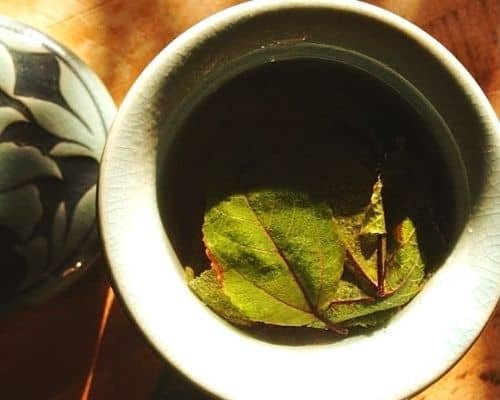
Here is an easy way to brew mamaki tea from fresh or dried leaves (or tea bags):
Step 1: Place 6 fresh or dried mamaki leaves (or 1 tea bag) into a teapot or use an electric kettle that has an infuser.
Step 2: Bring one cup of purified water to a boil.
Step 3: Pour boiling water over tea leaves and allow to steep for about 10 to 20 minutes (5 minutes for tea bag).
Step 4: Strain the liquid into a teacup. Add honey (or sugar), lemon, and milk to taste.
The recipe makes one cup of refreshing tea. Drink hot or cold and enjoy the subtle natural sweetness.
How Does it Taste?
This herbal tea has a smooth taste that resembles green tea but is less bitter and has a mild citrus flavor.
Where to Buy Mamaki Tea
Below are the best mamaki tea products available on Amazon:
- Nakihalani Farm Loose Leaf Mamaki Tea: I can recommend this organic high-quality mamaki tea for everyone who wants to try the herb. It comes in a 2-ounce bag and is free of any harmful chemicals, insecticides, and pesticides.
- Shaka Tea Mamaki Hawaiian Tea in Bottle – Mango Hibiscus: This refreshing and delicious ready-made tea drink is a hassle-free option for enjoying the health benefits of mamaki. It also contains hibiscus, natural mango flavor, monk fruit juice concentrate, and natural ginger extract. There are also other excellent flavors available such as Pineapple Mint.
If you buy some loose leaf mamaki tea, you can also get a proper tea container to keep it safe from humidity and UV rays.
Drink Mamaki to Your Health!
Mamaki tea may be the next to add to your herbal tea list. Keep in mind that mamaki tea benefits claims come from mostly traditional use by herbal practitioners in Hawaii.
The US Food and Drug Administration (FDA) has not yet made any statements concerning its use, safety, and side effects in humans. Therefore, consult your doctor or healthcare professional if you plan on using mamaki tisanes long-term or for a specific medical condition.
I hope you found this guide interesting!
-Joonas
PS. Here are a few more articles that you might like:
- Ashitaba Tea Health Benefits
- Best Herbal Teas for Stress and Anxiety
- Refreshing Thai Lemongrass Tea Recipe

